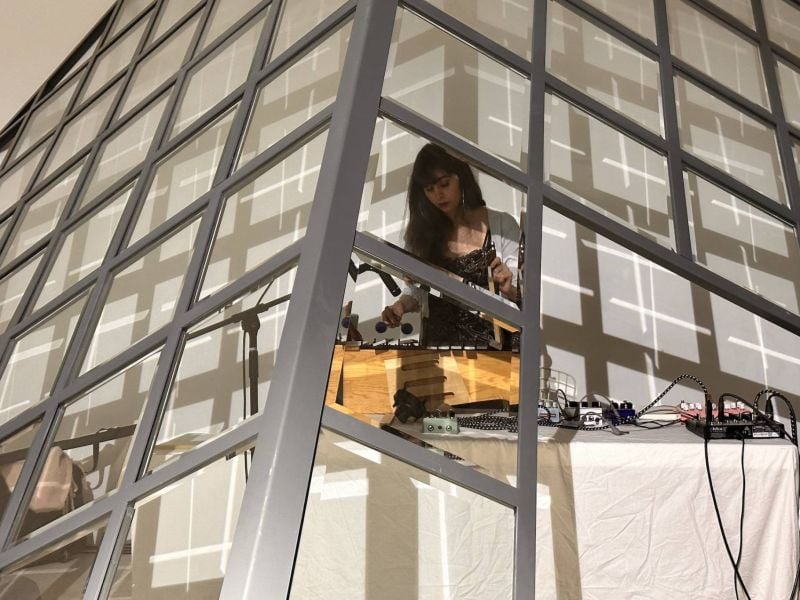
Yara al-Asmar bows a metallophone during her commissioned performance at Beirut Art Center. (Credit: Joseph Kesrouany courtesy of BAC)
BEIRUT — A four-sided pyramid has loomed over the Beirut Art Center (BAC) library since October 2023. Standing 440 cm tall, the tetrahedron-shaped structure (the library floor and wall provide two of its sides) measures 540 x 540 x 770 cm. Marwan Rechmaoui, who fashioned the piece, says it is made of “glass, iron, sweat and burns ... from the welding torch.”
“Municipalities,” as the installation is called, resonates with Rechmaoui’s sculptural practice, which has used building materials as media, and works that may conjure up Beirut’s urban fabric (“Beirut Caoutchouc,” 2004-2008, or “Blazon,” 2015), the city’s prominent modernist structures (“The Co-op,” 2019, among others) or morphologies of contemporary ruin (“Pillars,” 2014-2016).
The pyramid is the first of a series of pieces that BAC director Reem Shadid commissioned for BAC’s central hall, facilitated by Rafi Manoukian. Materially conspicuous — as much for the latticework of light and shadow the grid casts on the library walls as the structure itself — “Municipalities” exists in conjunction with a series of ephemeral sound art commissions. Rechmaoui’s space within a space was made to serve as a venue for solo performances by three contemporary musicians. Charbel Haber, who’s programmed these shows, launched the project with a solo in October. Fadi Tabbal played a set in December. On this February evening, Yara al-Asmar has entered the pyramid for an evening of ambient music.
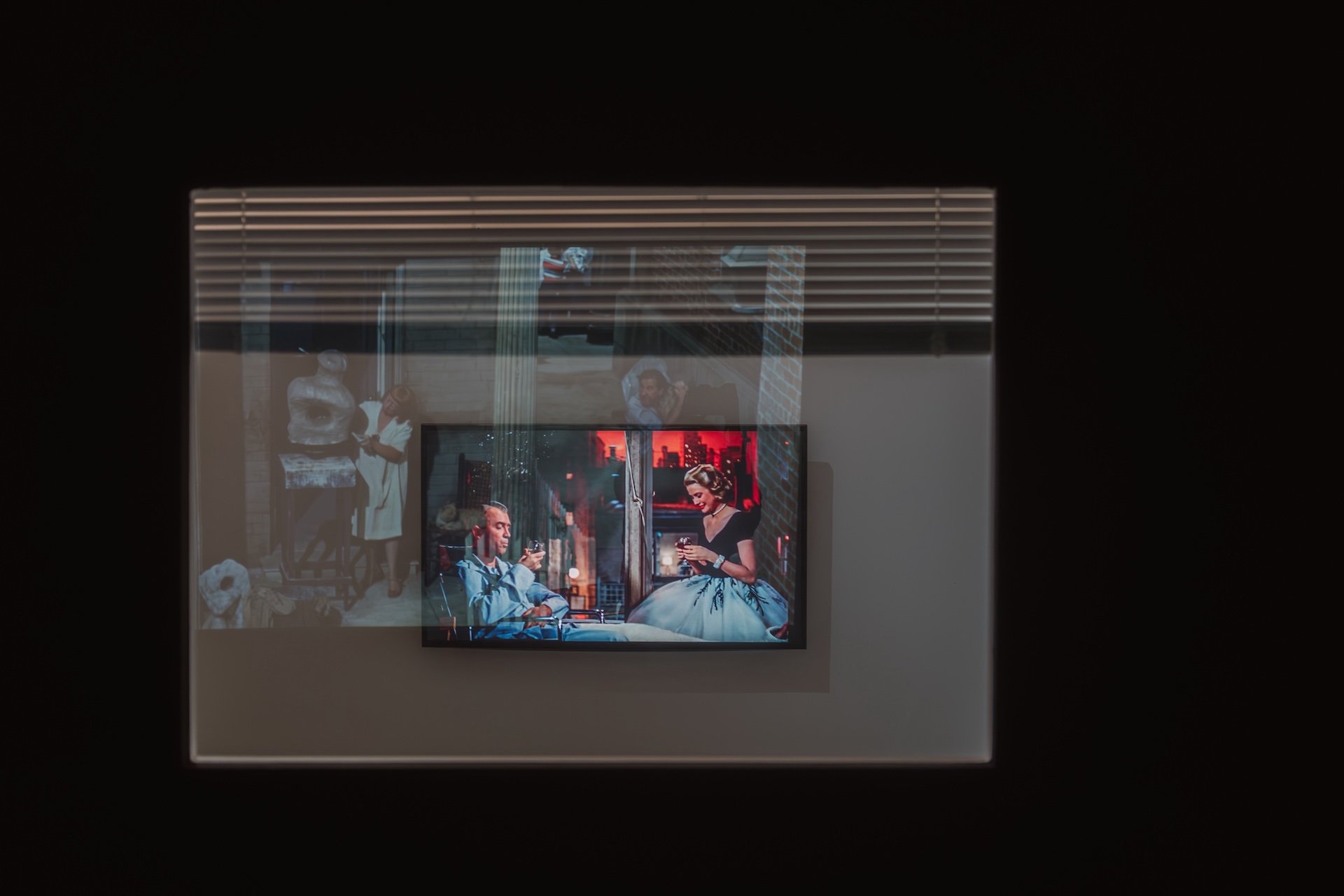 An installation view “Eyeing a Boring Couple Unselfconsciously,” with the reflection of “What Did One of the Neighbors Miss During His Photographic Assignment Abroad?” as seen during Jalal Toufic: “Five Hitchcock Films as You’ve Never Seen Them Before,” at Beirut Art Center. (Credit: Joseph Kesrouany courtesy of BAC)
An installation view “Eyeing a Boring Couple Unselfconsciously,” with the reflection of “What Did One of the Neighbors Miss During His Photographic Assignment Abroad?” as seen during Jalal Toufic: “Five Hitchcock Films as You’ve Never Seen Them Before,” at Beirut Art Center. (Credit: Joseph Kesrouany courtesy of BAC)
The three works so far performed in “Municipalities” are electronically enhanced — BAC’s interior acoustics, Shadid confides, are inhospitable — and recordings of each solo echo through the library in anticipation of the next act. The program culminates on April 19 with an ensemble improv concert featuring Asmar, Tabbal and Haber. After that, the pyramid comes down.
This evening, though, BAC is the site of an ephemeral confluence of Rechmaoui, Asmar and Jalal Toufic.
Messieurs Hitchcock and Toufic
A few steps away from “Municipalities,” exhibition hall 1 is hosting Toufic’s solo show “Five Hitchcock Films as You’ve Never Seen Them Before.” As the title suggests, these video pieces are unified by the artist-writer’s preoccupation with the work of UK-born filmmaker Alfred Hitchcock (1899-1980). The five films in question are “The 39 Steps” (1935), , “Rear Window” (1954), “Vertigo” (1958), “Psycho” (1960) and “The Birds” (1963).
Architect and budding curator Lin Dabbous worked with Shadid and Toufic to elaborate the gallery’s white-cube aesthetic into discrete installations centering on eight screens (nine, if you include that of the adjacent auditorium) accessorized with more or less comfortable seating and sparse décor, including a stuffed bird or two.
Perhaps the most cleverly deployed of the works are two of Toufic’s 2023 pieces, both of which sample segments from “Rear Window.” The first, titled “What Did One of the Neighbors Miss During His Photographic Assignment Abroad?” (21 minutes), draws upon vignettes of the humans that LB Jeffreys (the titular photographer) observes, gawking into his neighbors’ windows while laid up at home with a broken leg. You might see it as a montage from the perspective of the protagonist as voyeur. Toufic’s title toys with how Jeffreys would have missed these tableaux, had he been able to accept the assignment he’s offered early in Hitchcock’s film.
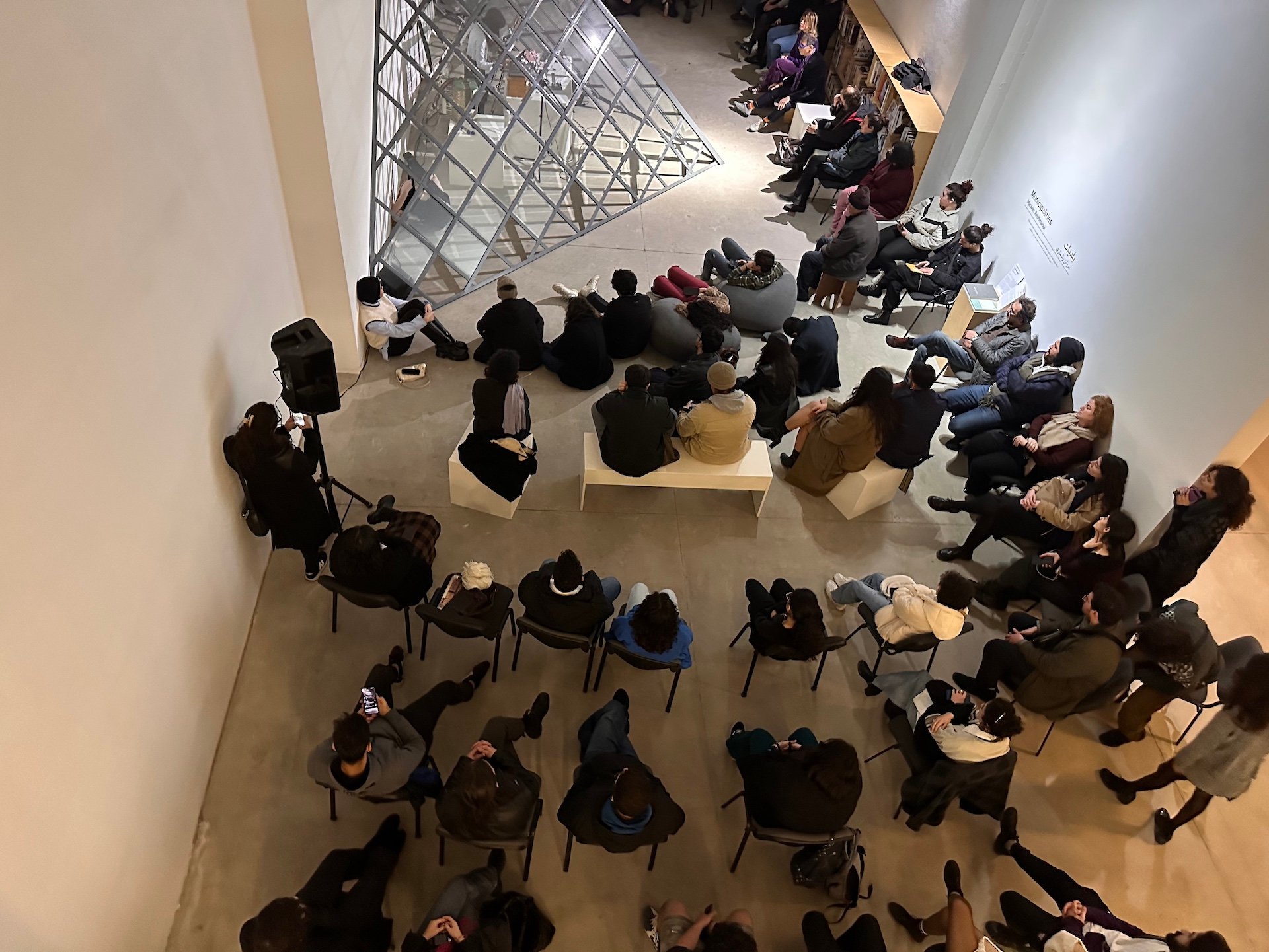 Yara al-Asmar performs her commissioned work at Beirut Art Center. (Credit: Joseph Kesrouany courtesy of BAC)
Yara al-Asmar performs her commissioned work at Beirut Art Center. (Credit: Joseph Kesrouany courtesy of BAC)
Complementing “Neighbors” is the 17-minute “Eyeing a Boring Couple Unselfconsciously,” which splices scenes of the photographer’s nurse telling him he ought to marry his girlfriend Lisa with others showing Lisa and Jeffreys enjoying a moment of chaste intimacy — a précis of ’50s Hollywood morality for the, by definition voyeuristic, audience.
Dabbous et al have enclosed “Neighbors” in a viewing room that defies convention — both in its plush seating and the glass windows installed in two of its walls. One aperture looks onto the gallery entrance and the installation of Toufic’s 2013 work “Variations on Guilt and Innocence in ‘39 Steps.’” The viewer is given an opportunity to glance up from the protagonist’s gaze to observe what’s happening on the far side of the glass, widening his or her field of voyeurism (whether a visitor watching “Variations on Guilt,” playing Tetris on his mobile or what). The second window requires aspiring voyeurs to glance over their shoulders to see what’s going on with “A Boring Couple” or if anyone is occupying that screen’s sole comfortable chair. Should a viewer on the far side of the window look over her shoulder, the effect is more satisfying, with a reflection of “A Boring Couple” vying with “Neighbors” for her attention.
History might have remembered Hitchcock as a celebrity melodramatist and thriller-maker were it not for the critically minded filmmakers of the French New Wave, who conferred an auteur’s heft to “Hitch” and provoked anglophone cineastes to reassess his craft. Toufic’s own career as an artist and theorist of images, mechanically reproduced and otherwise, might be seen in similar terms. While he’s never emulated Hitchcock’s box office penetration, Toufic’s writing has been influential to many artists — including Rechmaoui and his contemporaries, frequently termed “the ’90s generation,” post-Civil War Lebanon’s most-renowned creative grouping.
Over the years several of these artists and creatives have reflected upon Toufic’s significance to their respective practices and a number of them are contributing to this exhibition’s public program, much of which is unfurling throughout March 2024.
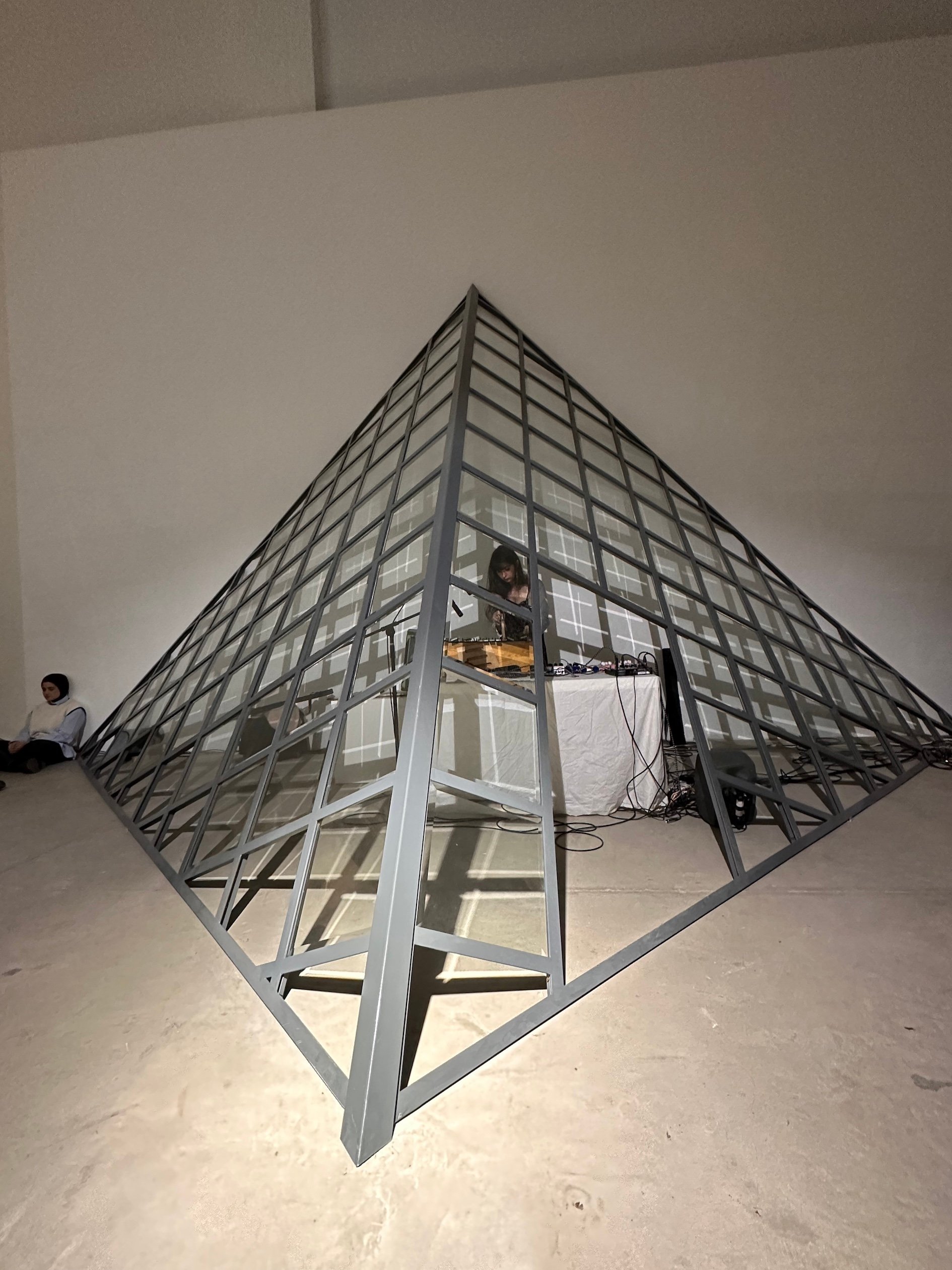 Marwan Rechmaoui’s installation “Municipalities,” 2023, up at Beirut Art Center library through March. (Credit: Joseph Kesrouany courtesy of BAC)
Marwan Rechmaoui’s installation “Municipalities,” 2023, up at Beirut Art Center library through March. (Credit: Joseph Kesrouany courtesy of BAC)
It would be foolhardy to attempt a summary of Toufic’s ideas here. That said, citing one of his core concepts may suggest why his writing has been so influential among this region’s contemporary artists. “The Withdrawal of Tradition Past a Surpassing Disaster,” the title of his 2009 monograph, offers a unique and thoughtful proposal for how to approach post-colonial aesthetics and artistic practice. Considering the persistence of catastrophe in the recent history of this region — Lebanon (since Oct. 2019, 1975, 1958 or 1918), Palestine (since Oct. 2023, 1947 or 1918) Syria, Iraq, Yemen, Sudan, take your pick — it is no surprise that Toufic’s ideas have become a sounding board thinking artists and critics alike.
In acknowledgment of Toufic’s impact on contemporary artists, BAC has made his writing integral to this exhibition. The center’s website and an onsite VR code will lead curious visitors to a selection of his writings. Those interested in a structured tour of Toufic’s ideas will find a series of lectures that art theorist Fares Chalabi delivered a couple of years back for an AUB class on Toufic’s thought.
Looping the acoustic
Yara al-Asmar is relatively new to Lebanon’s music scene. She emerged during the ferment following the popular demos of late 2019 and the ensuing economic collapse, and has come to be known for her hand-made puppetry and video work as well as composition and performance. She studied piano as a youngster and her principal instruments are acoustic — accordion and disassembled glockenspiel.
“It’s called a metallophone,” she explains after the show. “Sometimes I use a disassembled toy piano, basically a bunch of tuned metallic rods. What’s really great about toy pianos, at least the ones I’ve come across, is that each one is always a little bit dissonant, so there’s something really ghostly about striking it with a mallet.”
She approaches her instruments unconventionally, sometimes hammering the bars of the metallophone, sometimes bowing them.
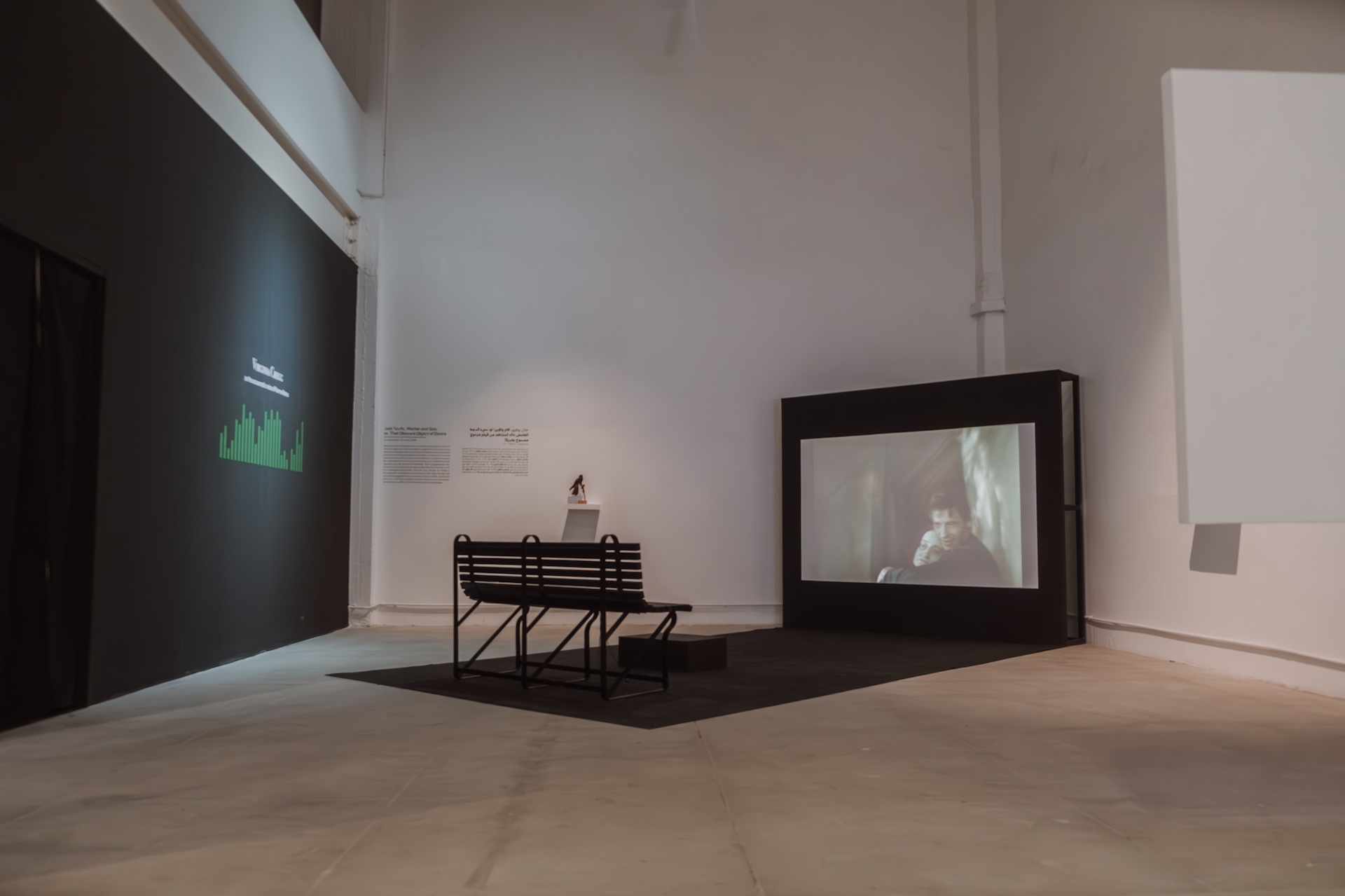 “Mother and Son or, That Obscure Object of Desire” (Scenes from an Anamorphic Double Feature), as seen during Jalal Toufic: Five Hitchcock Films as You’ve Never Seen Them Before, at Beirut Art Center. Visitors unfamiliar with Alfred Hitchcock’s works can watch some of his original films as well as Toufic’s pieces that reference them. (Credit: Joseph Kesrouany courtesy of BAC)
“Mother and Son or, That Obscure Object of Desire” (Scenes from an Anamorphic Double Feature), as seen during Jalal Toufic: Five Hitchcock Films as You’ve Never Seen Them Before, at Beirut Art Center. Visitors unfamiliar with Alfred Hitchcock’s works can watch some of his original films as well as Toufic’s pieces that reference them. (Credit: Joseph Kesrouany courtesy of BAC)
Asmar’s “Municipalities” set is oddly evocative of the segments of “Rear Window” being looped in the next room. Inside Rechmaoui’s installation, moving from accordion to metallophone and back, the performer seems oblivious to the spectators on the far side of the pyramid’s glass-and-metal grid.
The music is on the delicate side of ambient. Themes are explored and passages are looped back upon themselves while the musician carries the motifs forward, slightly altered. Asmar’s sounds might be aural variations on the repetitive theme of the structure containing them.
“The first time I saw a metallophone, it resonated so nicely that I wanted to bow it,” she recalls. “Then I came across Elliot Cole’s ‘Postludes For Bowed Vibraphone’ [basically an elaborate, motorized metallophone]. It’s performed by several players, each with two bows. I was in awe. Cole is the first composer I came across who uses the bow as the principal way to play the instrument.
“When I started playing metallophone I found I needed more than two bows, and my grandpa helped me make this little wooden contraption so I can use two bows with one hand.”
Recently Asmar has taken to using pedals to augment her sounds electronically. This, and her bowing of percussion instruments, will be familiar to anyone who’s attended an experimental music concert like those of Beirut’s Irtijal festival. Asmar hesitates to call her work “experimental.”
“It feels to me that a lot of people have experimented in the past for us to play this way today,” she reflects. “The first time someone called me an experimental musician … I felt a bit of a fraud, because … the people who came before really did things that no one had done before.”
Asmar usually composes single-handed and using pedals facilitates solo performance. She used no pedals in her debt album, “Home Recordings, 2018-2021.” Any additional effects on the album were added in post-production. On her 2023 sophomore record, “Synth Waltzes and Accordion Laments,” Asmar says two of the tracks are looped improv pieces.
“Before I used to only play acoustic sets. I’d usually spend two weeks preparing. What I’d work on most was transitions from the metallophone to the accordion, because I didn’t want any breaks ... It was a little bit chaotic,” she chuckles. “My hands were all over the place and I was moving very quickly to fill in the gaps. Some people made octopus jokes.
“I still don’t know how I feel about loopers,” she adds. “I wanted to keep struggling for some reason, but when I actually tried using pedals I found I could be relaxed. I don’t have to be running and fumbling with the accordion straps.”
Solo instincts aside, Asmar enjoys collaborations, as she demonstrated during an improv show with several Irtijal habitués at Metro al-Madina in February, working with Fadi Tabbal and Julia Sabra (aka Snakeskin). She also contributed to Elyse Tabet’s 2022 album “Low Toms Bright Bells and Darkest Spells.”
For her more recent work, Asmar has turned to old-school mechanical instruments — most prominently for her 2023 installation “Sonatina for 19 Music Boxes.”
“I made pre-composed motifs for music boxes and arranged them around a table,” she says. “I started the performance, then later invited people from the audience to come and put in the scrolls that they want and play them together, like a music box orchestra.”
Eventuall, most of her audience had got up to turn a crank or two.
“It was a nice way to end a performance,” she smiles. “I just packed up my things while they were playing with the installation, and left.”
“Five Hitchcock Films as You’ve Never Seen Them Before” is up through March 23. The exhibition’s public program continues March 15, 20 and 21.
